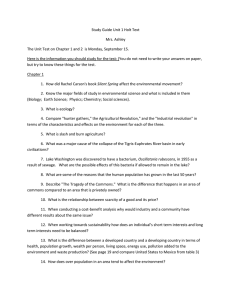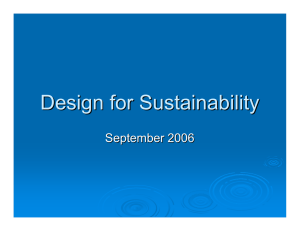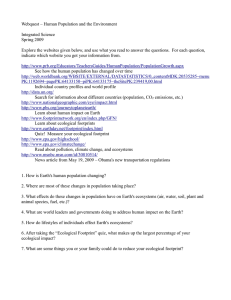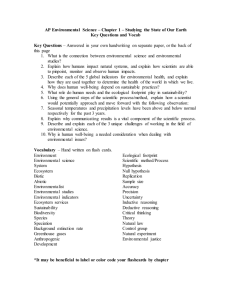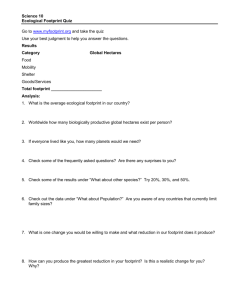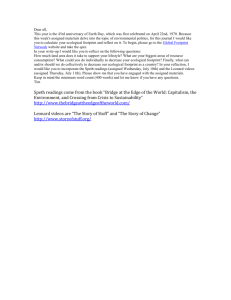V. GENERAL STRATEGIES FOR PLANNING AND ORGANIZING [F-10, F-11, &... This section begins with ways to assess the larger resource... food system. This is followed by two short pieces...
advertisement
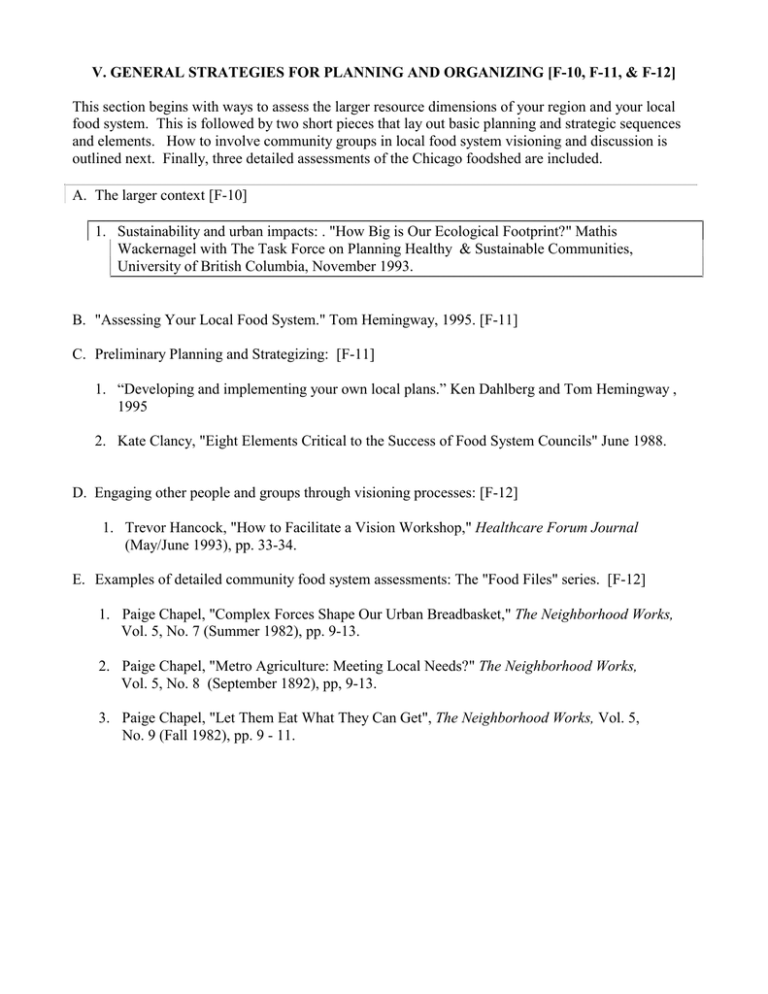
V. GENERAL STRATEGIES FOR PLANNING AND ORGANIZING [F-10, F-11, & F-12] This section begins with ways to assess the larger resource dimensions of your region and your local food system. This is followed by two short pieces that lay out basic planning and strategic sequences and elements. How to involve community groups in local food system visioning and discussion is outlined next. Finally, three detailed assessments of the Chicago foodshed are included. A. The larger context [F-10] 1. Sustainability and urban impacts: . "How Big is Our Ecological Footprint?" Mathis Wackernagel with The Task Force on Planning Healthy & Sustainable Communities, University of British Columbia, November 1993. B. "Assessing Your Local Food System." Tom Hemingway, 1995. [F-11] C. Preliminary Planning and Strategizing: [F-11] 1. “Developing and implementing your own local plans.” Ken Dahlberg and Tom Hemingway , 1995 2. Kate Clancy, "Eight Elements Critical to the Success of Food System Councils" June 1988. D. Engaging other people and groups through visioning processes: [F-12] 1. Trevor Hancock, "How to Facilitate a Vision Workshop," Healthcare Forum Journal (May/June 1993), pp. 33-34. E. Examples of detailed community food system assessments: The "Food Files" series. [F-12] 1. Paige Chapel, "Complex Forces Shape Our Urban Breadbasket," The Neighborhood Works, Vol. 5, No. 7 (Summer 1982), pp. 9-13. 2. Paige Chapel, "Metro Agriculture: Meeting Local Needs?" The Neighborhood Works, Vol. 5, No. 8 (September 1892), pp, 9-13. 3. Paige Chapel, "Let Them Eat What They Can Get", The Neighborhood Works, Vol. 5, No. 9 (Fall 1982), pp. 9 - 11. HOW BIG IS OUR ECOLOGICAL FOOTPRINT? USING THE CONCEPT Of APPROPRIATED CARRYING CAPACITY FOR MEASURING SUSTAINABILITY by MATHIS WACKERNAGEL with The Task Force on Planning Healthy & Sustainable Communities, The University of British Columbia People depend on nature, which provides a steady supply of the basic requirements for -life Energy is needed for heat and mobility, wood for housing and paper products, and we need quality food and clean water for healthy. living. Through a process called "photosynthesis" green plants convert sunlight, carbon dioxide, nutrients and water into plant matter, and all the food chains which support animal life - including our own are based on this plant matter. Nature also absorbs our waste products, and Figure 1: Human life is interwoven with nature provides life-support services such as climate stability and protection from ultra-violet radiation. Further, nature is a source of joy and inspiration. Figure I shows how very tightly human life is interwoven with nature, a connection we often forget or ignore. Since most of us spend our lives in cities and consume goods from all over the world, we tend to view nature as a collection of commodities or a place for recreation, rather than the very source of our existence. "The Ecological Footprint is the land that would be required on this planet to support our current lifestyle forever.” Figure 2: The Ecological Footprint If we're to continue to have good living conditions, we must ensure that nature's productivity Isn't used more quickly than it can be renewed, and that waste isn't discharged more quickly than nature can absorb it. We know from the increasing loss of forests, soil erosion and contamination, fishery depletion, loss of species and the accumulation of greenhouse gases that our current overuse of nature is compromising our future wellbeing. To find out whether nature provides enough "resources" to secure good living conditions for, everyone in a community, the Task Force on Planning Healthy and Sustainable Communities at the University of British Columbia has developed an ecological accounting tool that uses land area as its measurement unit. Various categories of human consumption are translated into the areas of productive land required to provide those items. From that, the area of land required by a given group of people (household, city or country) provide its resources and assimilate its waste products can be calculated. This land area is known as the Appropriated Carrying Capacity or, more simply and graphically, the group's ecological footprint (figure 2). It's the land that would be required on this planet to support our current lifestyle forever. Our current economy has given rise to increasing demands which compete for dwindling supplies of life's basic necessities such as food, clean water, etc. A group’s ecological footprint can be used to measure its current consumption against projected requirements and point out likely shortfalls. In this way society as a whole can compare the choices we need to make in the near future about our demands on nature - or else nature will make our choices for us. We'll have to look at issues like long term ecological sustainability as they relate to future economic health. Table I shows the ecological footprint of an average Canadian, i.e. the amount of land required from nature to support each individual's present consumption. This adds up to over 4.8 hectares, or an area 220 metres long by 220 metres wide roughly comparable to three city blocks. The column on the left shows various consumption categories, and the (coal, oil and natural gas). "Built Environment" means land that's no longer available for nature's production because it's been paved over or used for building. Examples of what's included in "Resources in Services" are the fuel needed to heat a hospital, or the paper and electricity used to produce a bank statement. To use the table to find out how much agricultural land is required to produce the average Canadian's food for instance, you'd read across the "Food" row to the "Agricultural Land"' column, and find that 0.9 hectares of land is needed. headings across the top show land use categories. This adds up to 4.8 hectares... roughly comparable to three city blocks. "Energy" as used in the talk means how much land would be necessary for the long term provision of a biological substitute for fossil fuels Table 1: The ecological footprint of the average Canadian, in hectares per capita. Energy Built Environment Food 0.4 Housing 0.5 0.1 Transport 1.0 0.1 Consumer Goods 0.6 Resources in Services 0.4 TOTAL 2.9 Agricultural Land Forest 0.9 TOTAL 1.3 0.4 1.0 1.1 0.2 0.2 1.0 0.4 0.2 1.1 0.6 4.8 In figure 3 there’s a comparison of the ecological footprints of various Canadian households. Figure 3 15 13.5 10 5 3.1 3.9 4.8 0 A B C D A. SINGLE PARENT WITH CHILD – ANNUAL HOUSEHOLD EXPENDITURE $16,000 B. STUDENT LIVING ALONE – ANNUAL HOUSEHOLD EXPENDITURE $10,000 C. AVERAGE CANADIAN FAMILY, 2.72 PEOPLE – ANNUAL HOUSEHOLD EXPENDITURE $37,000 D. PROFESSIONAL COUPLE, NO CHILDREN – ANNUAL HOUSEHOLD EXPENDITURE $79,000 The ecologically productive land available to each person on Earth has decreased over the last century (figure 4). At the moment there is, on average, 1.6 hectares (about one City block), or one-third of the area which each Canadian is currently using according to Table 1. . In contrast, the land appropriated by richer countries has increased. This means that if everyone on Earth lived like the average Canadian, we'd need at least three Earths to provide all the material and energy essentials we currently use (figure 5). If the world's population continues to grow as anticipated, by the year 2030 there will be 10 billion people, each of whom will have an average of only 0.9 hectares of productive land available, assuming there's no further soil degradation. This shows the pressure of population size on nature's productivity. The numbers become really interesting when you look at the land area that people in North America actually use. Figure 6 shows the ecological footprint for the Lower Fraser Valley, the area east of Vancouver, which contains 1.7 million people or 4.25 people per hectare. The area is far smaller than that needed to supply the resources for its population. If the average Canadian needs 4.8 hectares as shown in table 1, then the Lower Fraser Valley needs an area 20 times larger than what's actually available for food, forestry products and energy. Holland has a population of 15 million people, or 4.40 people per hectare, and although Dutch people consume less than Canadians on average, they still require more than 15 times the available land for food, forest products and energy. In other words, human settlements don't affect only the area where they're built. Increasing density in cities can lead to lower land use requirements, not only because of a reduction in the built environment, but also because of lifestyles which are less energy intensive. For example, a recent study of the San Francisco area found that when residential density was doubled, private transportation was reduced use by 20 to 30 percent. It's also been shown that residential heating requirements can be reduced significantly if housing is grouped rather than free-standing. Our challenge is to find a way to balance human consumption and nature's limited productivity in order to ensure that our communities are sustainable locally, regionally and globally. We don't have a choice about whether to do this, but we can choose how we do it. In fact, many people concerned with these issues believe that if we choose wisely now, there's still time for us to make our communities more sustainable, and at the same time improve our quality of life "Buy items made orgrown locally rather than far away." There are three key requirements for developing a sustainable community (a) Ecological health. Use nature's productivity without damaging it. (b) Community health. Foster social wellbeing through the promotion of fairness, equity and cooperation. (c) Individual health. Secure food, shelter, health care, education etc. .for everyone. This means working to integrate environmental, economic and social policies so that economic success, ecological integrity and social health .become compatible. In order to make our communities more livable and sustainable we can work towards change at the personal, urban and commercial levels. AT HOME WE CAN. 1. start composting 2. use more energy-efficient light bulbs, shower heads etc 3. switch to forms of recreation and tourism which have a low impact on the environment 4. grow some of our own food 5. live closer to work (or the other way around) 6. use bicycles and public transport rather than cars 7. buy items made or grown locally rather than far away Households can start by reducing their resource consumption. At the urban level we must develop an infrastructure that leaves options open, rather than one which dictates resource-intensive lifestyles for our own and future generations. Along with these lifestyle changes, there must be changes in our economies. This approach differs from today's global economy which favors Urban Industrial centres, and requires the support and involvement of people in each sector of society. We can all make a difference. Influential groups are: Politicians (MPs, MLAs, City Councillors, etc), who can initiate OF support sustainability Programs and projects, particularly at the infrastructure level They can set up screening processes which will take ecological impact into account when assessing a budget or project, and they can encourage the use of the concept of sustainability by the government. They can persuade their parties to develop sustainability strategies, Involve the public, and discuss the dilemmas being faced. They can support community groups working towards sustainable societies. Administrators and planners, who can help politicians write appropriate legislation and ensure that existing policies are followed. They too can involve the public, present them with the dilemmas and invite input. They can encourage people to participate in shaping the future of their community, and support and assist community groups making positive contributions to society CITIES AND TOWNS CAN: 1. plan attractive increased population density areas such as town centres and urban 2. 3. 4. 5. 6. 7. 8. villages instead of accommodating further sprawl offer living, working and shopping spaces in integrated neighbourhoods reallocate urban space to encourage decreased use of cars (e.g. reduce road and parking space) and increased use of public transport, bicycles mid walking (e.g. build bicycle 'speedways and attractive pedestrian areas) encourage the planting of trees and greenspaces establish urban land-trusts to give the community more control over land use promote various kinds of affordable high-density housing such as secondary suites and cooperatives introduce housing construction guidelines which minimize the consumption of resources develop comprehensive waste reduction. systems which include municipal resource reuse and reduction schemes The general public, which is all of us -possibly the most important group! We can look at our lifestyles, think about what's important to us, and start family and friends thinking too. Let's get involved and participate in community and municipal groups. Write and talk to politicians at a local, regional or national level, and let them know we want to work with them to develop our communities sustainably. IN DOING BUSINESS WE CAN: 1. rely on using locally available resources rather than imported ones 2. regain local control over production and distribution of those resources 3. secure local needs so that the long term livelihood of a region can be protected without compromising the livelihoods of other people in other regions 4. charge the true costs for private transportation, pollution and resource use 5. support community-based non-cash, volunteer and mutual aid networks 6. encourage ecologically sound businesses lifestyles, and tax and regulate unsustainable behaviour, 7. offer tax breaks and other incentives for encouraging sustainable All of us - including politicians and planners - are consumers of ,nature's productivity. We must work together to achieve a more sustainable way of living now in order to ensure that resources continue to be available not only for ourselves, but also for future generations. "We must work together to ensure that resources continue to be available for future generations. If you're interested in finding out more about the issues raised in this pamphlet, we suggest the following reading material. General "For the Common Good Redirecting the Economy towards Community, the Environment and a Sustainable Future" by, Herman E Daly and John B Cobb., 1989. Beacon Press, Boston. "Toward Sustainable Communities: A Resource Book for Municipal and Local Governments" by Mark Roseland, 1992. Available free of charge from the National Round Table on the Environment and the Economy. Ottawa - phone (613) 992-7189. Ecological Footprint: "Ecological Footprints and Appropriated Carrying Capacity: What Urban Economics Leaves Out" by Bill Rees. 1992. Environment and Urbanization Vol 4. No 2. pages 121-130. "Ecological Footprints and Appropriated Carrying Capacity Measuring the Natural Capital Requirements of the Human Economy" by Bill Rees and Mathis Wackernagel 1993. Forthcoming in Investing in Natural Capital. edited by C Folke, M Hammer, A-M Jansson and R Constanza. "How Big is our Ecological Footprint? A Handbook for Estimating a Community"s Appropriated Carrying Capacity" by Mathis Wackernagel et al, 1993. A discussion draft prepared for the Task Force on Planning Healthy and Sustainable Communities Vancouver. For further information, please contact: Janette McIntosh, Coordinator The Task Force on Planning Healthy and Sustainable Communities The University of British Columbia Department of Family Practice 5804 Fairview Avenue Vancouver, BC Canada V6T IZ3 phone: (604) 822-4366, fax: (604) 822-6950 This pamphlet may he reproduced. If excerpts are quoted, the source should be credited Graphis: Phil Testemale Editing C Desktop Publishing: The Write Stuff printed on recycled paper November 1993
